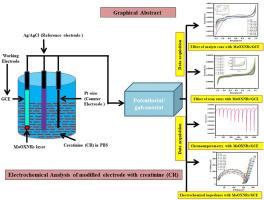Rapid, efficient, and sensitive electrochemical nanosensors for the detection of creatinine biomolecule
IF 4.6
3区 工程技术
Q2 ENGINEERING, ELECTRICAL & ELECTRONIC
引用次数: 0
Abstract
The creatinine is an important nitrogenous based organic compound recovered by the process of catabolism. Creatinine level in human blood samples are very essential because their level directly reflect to the renal, muscle, and thyroid function in human body. From the level of creatinine in human blood easily monitored and diagnosed the condition of patients. The current study initially, demonstrate the synthesis of molybdenum oxide nanorods (MoOXNRs) via solution process and characterized with a number of equipment's in detail. Thereafter, the MoOXNRs powder was utilized for sensing aptitude of creatinine (CR) with glassy carbon electrode (GCE). A number of parameters such as effect of concentrations, scan rate, cyclic test were opted and performed for the electrochemical study. A variety of analyte concentrations (CR-0.98 × 10−6 M to 500 × 10−6 M in PBS) were chosen to assess the effectiveness of the electrode based sensor (MoOXNRs/GCE). The sensor was also checked from a very low to high scan rate (5 × 10−3, to 15 × 10−2 V/s) respectively. The chronoampherometric (CrA) analysis was conducted from initial to longer intermissions (0–1000s). The cycle response (CR) and electrochemical impedance (EIS) studies were also perform and based on the data a circuit was constructed. The quantitative and qualitative detections limits values of LOD and LOQ of MoOXNRs/GCE-IPa (0.100 × 10−5: 0. 304 × 10−5) and MoOXNRs/GCE-IPc (0.619 × 10−4: 0.187 × 10−5) were also calculated. Apart from this, a possible mechanism was described in detail.

用于肌酸酐生物分子检测的快速、高效、灵敏的电化学纳米传感器
肌酐是一种重要的氮基有机化合物,可通过分解代谢过程回收。人体血液中肌酐水平的高低直接反映人体的肾脏、肌肉和甲状腺功能,因此肌酐水平是人体必不可少的。从人体血液中肌酐的水平可以方便地监测和诊断患者的病情。本研究首先展示了通过溶液法合成氧化钼纳米棒(MoOXNRs),并对许多设备进行了详细的表征。然后,将MoOXNRs粉末用于玻璃碳电极(GCE)对肌酐(CR)的感应能力。选择了浓度、扫描速率、循环试验等参数进行了电化学研究。选择各种分析物浓度(CR-0.98 × 10 - 6 M至500 × 10 - 6 M PBS)来评估基于电极的传感器(MoOXNRs/GCE)的有效性。传感器也分别从非常低到高扫描速率(5 × 10−3,到15 × 10−2 V/s)进行了检查。从初始到更长的间歇时间(0 - 1000秒)进行了时间弧度(CrA)分析。循环响应(CR)和电化学阻抗(EIS)也进行了研究,并在此基础上构建了电路。MoOXNRs/GCE-IPa的LOD和LOQ的定量和定性检测极限值为0.100 × 10−5:0。304 × 10−5)和MoOXNRs/GCE-IPc (0.619 × 10−4:0.187 × 10−5)。除此之外,还详细描述了一种可能的机制。
本文章由计算机程序翻译,如有差异,请以英文原文为准。
求助全文
约1分钟内获得全文
求助全文
来源期刊

Materials Science in Semiconductor Processing
工程技术-材料科学:综合
CiteScore
8.00
自引率
4.90%
发文量
780
审稿时长
42 days
期刊介绍:
Materials Science in Semiconductor Processing provides a unique forum for the discussion of novel processing, applications and theoretical studies of functional materials and devices for (opto)electronics, sensors, detectors, biotechnology and green energy.
Each issue will aim to provide a snapshot of current insights, new achievements, breakthroughs and future trends in such diverse fields as microelectronics, energy conversion and storage, communications, biotechnology, (photo)catalysis, nano- and thin-film technology, hybrid and composite materials, chemical processing, vapor-phase deposition, device fabrication, and modelling, which are the backbone of advanced semiconductor processing and applications.
Coverage will include: advanced lithography for submicron devices; etching and related topics; ion implantation; damage evolution and related issues; plasma and thermal CVD; rapid thermal processing; advanced metallization and interconnect schemes; thin dielectric layers, oxidation; sol-gel processing; chemical bath and (electro)chemical deposition; compound semiconductor processing; new non-oxide materials and their applications; (macro)molecular and hybrid materials; molecular dynamics, ab-initio methods, Monte Carlo, etc.; new materials and processes for discrete and integrated circuits; magnetic materials and spintronics; heterostructures and quantum devices; engineering of the electrical and optical properties of semiconductors; crystal growth mechanisms; reliability, defect density, intrinsic impurities and defects.
 求助内容:
求助内容: 应助结果提醒方式:
应助结果提醒方式:


